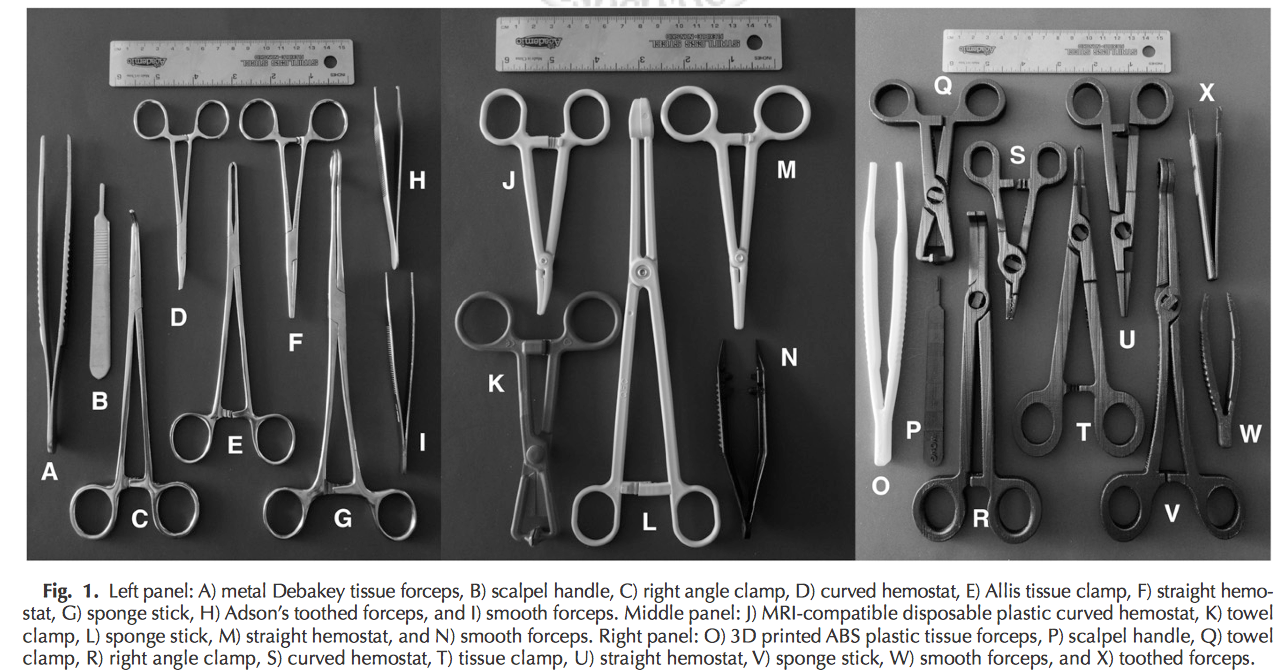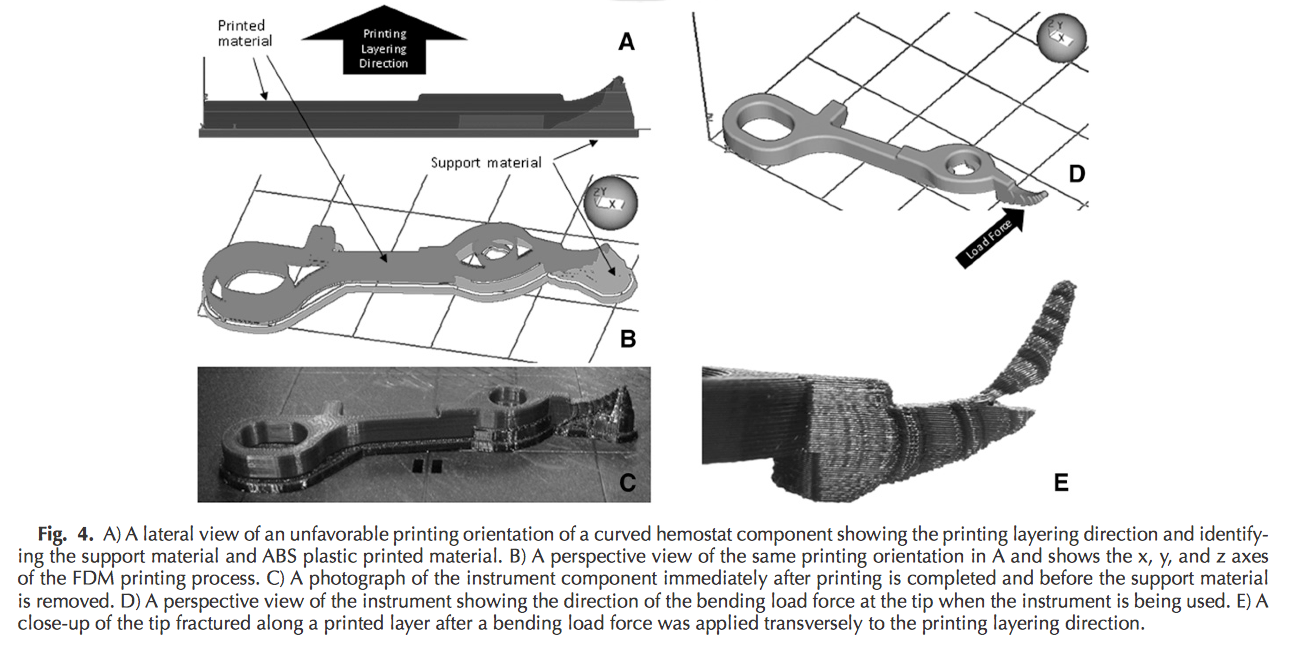Looking toward a future when space missions might occur at great distances over even longer periods of time, means being prepared for any number of emergencies or eventualities that could occur. While it would not be an ideal situation for someone to need to perform surgery in space, accidents or unexpected illnesses do occur and must be prepared for.
 Imagining this future scenario, researchers Dr. Julielynn Y. Wong from the Center for Innovative Technologies and Public Health in Toronto and Dr. Andreas C. Pfahnl of Devicix, LLC in Eden Parie, MN undertook a study to examine the possibilities for 3D printing surgical instruments. They shared their results in the journal Aviation, Space, and Environmental Medicine. Should this prove to be a feasible mechanism, by which instruments can be created, having a 3D printer and filament on board would mean that instruments could be produced on an ‘as needed basis’, thereby greatly reducing the amount of preparatory supplies that would have to be loaded. In addition, this capability would expand the ability of any on flight medical team to respond to nearly any medical emergency.
Imagining this future scenario, researchers Dr. Julielynn Y. Wong from the Center for Innovative Technologies and Public Health in Toronto and Dr. Andreas C. Pfahnl of Devicix, LLC in Eden Parie, MN undertook a study to examine the possibilities for 3D printing surgical instruments. They shared their results in the journal Aviation, Space, and Environmental Medicine. Should this prove to be a feasible mechanism, by which instruments can be created, having a 3D printer and filament on board would mean that instruments could be produced on an ‘as needed basis’, thereby greatly reducing the amount of preparatory supplies that would have to be loaded. In addition, this capability would expand the ability of any on flight medical team to respond to nearly any medical emergency.
What the researchers did to approach this problem, was to break it into several components. The first phase of understanding the possibilities for such a concept was to study the creation of 3D printed surgical instruments here on earth. In this case, they chose to evaluate Fused Deposition Modeling as a method for creating 10 surgical instruments from ABS plastic. They were particularly interested in gathering data regarding instrument fabrication times, the perceived functional performance of such instruments, and the optimal parameters for creation of the instruments using FDM printing of ABS plastic.
The research team used SolidWorks 2012 to model a towel clamp, sponge stick, scalpel handle, straight hemostat, curved hemostat, Adson’s toothed forceps, Debakey tissue forceps, smooth forceps, Allis tissue clamp, and right angle clamp, for a total of ten instruments. They chose this tool set because of the multiple functions that each tool performs, making it a likely candidate for any particular surgical intervention. As these tools are currently produced in stainless steel and in a disposable plastic version, there were models easily available for study. However, modifications to the original designs had to be made to account for differences in the material properties of ABS printed plastic.
 The first phase of the investigation was to determine if FDM printing of ABS plastic would even be a viable manner in which to produce these tools, as otherwise the other two primary questions would be irrelevant. The researchers began by subjecting samples to a series of tests, designed to provide information about the material’s stiffness and yield strength. The data gathered through those tests was then applied to the design and fabrication of the actual instruments.
The first phase of the investigation was to determine if FDM printing of ABS plastic would even be a viable manner in which to produce these tools, as otherwise the other two primary questions would be irrelevant. The researchers began by subjecting samples to a series of tests, designed to provide information about the material’s stiffness and yield strength. The data gathered through those tests was then applied to the design and fabrication of the actual instruments.
The STL files created taking the material properties data into account were then printed on a Dimension Elite 3D printer, using Stratasys CatalystEX 4.0.1 3D printing software. The layer resolution was set to 0.178 mm, the model interior to ‘solid,’ and the support fill to ‘sparse.’ Each instrument was printed at the orientation that would best serve its use. After each print, the instruments were assessed for functionality and further modifications to the design were made as necessary.
 When the instruments had met the performance standards indicating the possibility for their creation, the researcher moved to the next phase of their investigation: experiential assessment. For this portion of the experiment, they reduced the number of instruments being tested to five. 13 surgeons were asked to complete a series of tasks with a set of traditional instruments and then with a set of 3D printed instruments. When they completed the tasks, they were given a survey designed to reflect their evaluation of the experience. In addition, the surgeons were timed during task completion in order to better understand the quantitative differences that the different materials might present.
When the instruments had met the performance standards indicating the possibility for their creation, the researcher moved to the next phase of their investigation: experiential assessment. For this portion of the experiment, they reduced the number of instruments being tested to five. 13 surgeons were asked to complete a series of tasks with a set of traditional instruments and then with a set of 3D printed instruments. When they completed the tasks, they were given a survey designed to reflect their evaluation of the experience. In addition, the surgeons were timed during task completion in order to better understand the quantitative differences that the different materials might present.
As a result, the investigators learned that the strength and stiffness of the horizontally printed ABS plastic was decreased as a result of the FDM layering process. However, creating thicker instruments, especially in areas that receive high bending loads, worked to mitigate weakening. The print orientation must be transverse to the loading force direction in order to create instruments that will not break.
Looking at the study as a whole, it appears that 3D printing is an extremely viable method for creating surgical instruments on earth. All surgical tasks performed in the study were successful when using the 3D printed versions of the surgical instruments. A caveat, however, is the time that it takes to produce the instruments, approximately one and one half hour, renders them impractical for emergency situations. At this stage, it may be more realistic to imagine them as being used to replenish supplies. In addition, it is highly likely that redesigning smaller instruments in the short term can increase the speed of printing, and in the long-term 3D printing technology advances may increase the speed further.
Other advantages to 3D printing surgical instruments range from the ease of tool redesign (such as to accommodate a left hand dominate back up medical officer) to reduction in costs and improvements in the self-sufficiency of space missions. Therefore, there is great promise for further experimentation to be done in zero gravity environments.
Additional investigation is required to determine the sterility and sterilization of 3D printed ABS surgical tools. This study also raises a great number of questions for future research regarding the possibilities presented by 3D printing in conjunction with the operation of the International Space Station.
While it’s clear we have a long way to go before we can expect to travel to Mars and beyond, 3D printing may be bringing that day closer than it has ever been. What do you think about 3D printing surgical instruments in space? Will it one day be a reality? Discuss in the 3D printing of surgical instruments forum thread on 3DPB.com
Subscribe to Our Email Newsletter
Stay up-to-date on all the latest news from the 3D printing industry and receive information and offers from third party vendors.
You May Also Like
HP & INDO-MIM Collaborate to Boost Metal 3D Printing in India
HP Inc. and INDO-MIM, a US- and India-based supplier of metal injection molding (MIM) powders and contract manufacturer, have announced that the two companies will collaborate to accelerate additive manufacturing...
New Report: Semiconductor Industry to See $1.4B in 3D Printing Revenues by 2032
“The semiconductor sector has become the most strategically significant area of global industry.” Truer words are hard to come by when it comes to the modern world, and they are...
One of US’s Largest Machine Tool Resellers to Offer Stratasys 3D Printing
In a key move for the additive manufacturing (AM) stalwart, Stratasys (Nasdaq: SSYS) has announced a strategic partnership with Select Additive Technologies, a division of Morris Group, Inc., which is...
3D Printing Unpeeled: Orbex Investment, IndoMIM and HP, Ultrasonic Waves
INDO-MIM has bought three HP Metal Jet S100 printers, operating two in India and one in Texas. This is a win for HP because the company has deep experience in...





























